Nikon Prostaff 5 User Manual
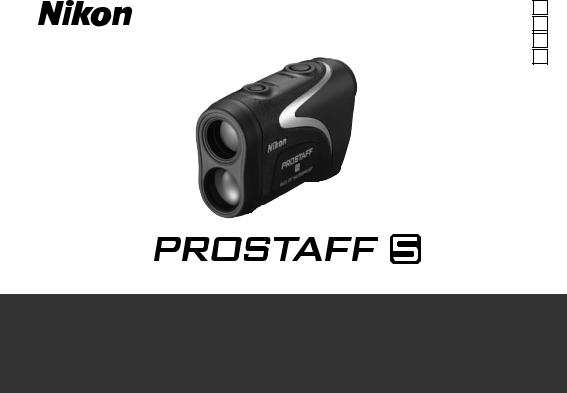
En
Es
Fr
Pt
Instruction manual/Manual de instrucciones/ Manuel d’utilisation/Manual de instruções
English........................................... |
p. 4-19 |
Français....................................... |
p. 20-35 |
Español........................................ |
p. 36-51 |
Português brasileiro.................. |
p. 52-67 |

Es
Fr
Pt
English |
|
CONTENTS |
|
Cautions before use ........................................ |
5-8 |
Key features ............................................................ |
9 |
Nomenclature/Composition .......................... |
10 |
Changing battery ............................................... |
11 |
Internal display ................................................... |
12 |
Operational Summary ............................... |
13-14 |
Specifications ............................................... |
15-16 |
Others ..................................................................... |
17 |
Troubleshooting/Repair ........................... |
18-19 |
Cautions before use
Thank you for purchasing the Nikon Laser Rangefinder PROSTAFF 5.
The PROSTAFF 5 is a high-spec laser rangefinder specialized for measuring actual distance intended for use in leisure, sports and other outdoor situations.
Please observe the following guidelines strictly so you can use the equipment properly and avoid potentially hazardous problems.
Use of controls or adjustments or performance of procedures other than those specified herein may result in hazardous radiation exposure.
qBefore using this product, read thoroughly the “Cautions before use” and instructions on correct usage accompanying the product.
qKeep this manual within reach for easy reference.
qDo not disassemble or repair this product by yourself, this may result in a serious problem. A product that has been disassembled or repaired is not guaranteed by the manufacturer.
•Specifications and design are subject to change without notice.
•No reproduction in any form of this manual, in whole or in part (except for brief quotation in critical articles or reviews), may be made without written authorization from NIKON VISION CO., LTD.
Es
Fr
Pt
4 |
5 |

Es
Fr
Pt
Cautions before use
Please observe the following guidelines strictly so you can use the equipment properly and avoid potentially hazardous problems. Before using this product, read thoroughly the “Cautions before use” and instructions on correct usage accompanying the product. Keep this manual within reach for easy reference.
 WARNING
WARNING
This indication alerts you to the fact that any improper use ignoring the contents described herein can result in potential death or serious injury.
 CAUTION
CAUTION
This indication alerts you to the fact that any improper use ignoring the contents described herein can result in potential injury or material loss.
SAFETY PRECAUTIONS (Laser)
The Nikon Laser Rangefinder uses an invisible laser beam. Be sure to observe the following:
 Warning
Warning
•Do not depress the POWER button while looking into the optics from the objective side. Failure to do this may negatively affect or damage your eyes.
•Do not aim at the eye.
•Do not point the laser at people.
•Do not operate the unit with other additional optical elements, such as lenses or binoculars. Using an optical instrument together with the Nikon Laser Rangefinder increases the danger of damaging the eyes.
•When not measuring, please keep your fingers away from the POWER button to avoid accidentally emitting the laser beam.
•When not in use for an extended period, please remove the battery from the body.
•Do not disassemble/remodel/repair the Nikon Laser Rangefinder. The emitting laser may be harmful to your health. A product that has been disassembled/remodeled/repaired is not guaranteed by the manufacturer.
•Keep the Nikon Laser Rangefinder out of reach of children when stored.
•If the Nikon Laser Rangefinder’s body cover is damaged, or if it emits a strange sound due to dropping or some other cause, remove the battery immediately and stop using.
SAFETY PRECAUTIONS (Monocular)
The Nikon Laser Rangefinder employs a monocular in its optical system in order to aim at the target. Be sure to observe the following:
 Warning
Warning
•Never look directly at the laser beam or directly at the sun when using the Nikon Laser Rangefinder.
 Cautions
Cautions
•When not using the Nikon Laser
Rangefinder, do not push the
POWER button.
•Do not use this product while walking. Failure to observe this may cause injury or malfunction as a result of walking into something, hitting others, falling or other accidents.
•Do not swing around by the strap.
This may result in hitting others and cause injury.
•Do not place this product in an unstable place. Failure to observe this may result in falling or dropping and cause injury or malfunction.
•Keep the plastic bag used to wrap this product or other small parts out of reach of children.
•Prevent children from putting rubber eyecup or small parts, etc. into their mouths. If children swallow such parts, consult a doctor immediately.
•If using the rubber eyecup for a long period of time, some people may suffer skin inflammation. If any symptoms occur, stop using it and consult a doctor immediately.
•When carrying the Nikon Laser
Rangefinder, store it in the soft case.
•If your Nikon Laser Rangefinder should fail to operate correctly, discontinue use immediately and consult with your local dealer for instructions on where to send it for repair.
SAFETY PRECAUTIONS (lithium battery)
If handled incorrectly, the battery may rupture and leak, corroding equipment and staining clothing. Be sure to observe the following:
•Install the battery with the + and – poles positioned correctly.
•The battery should be removed when exhausted or during extended periods of non-use.
•Do not short the end terminal of the battery chamber.
•Do not carry together with keys or coins in a pocket or bag, it may short and cause overheating.
•Do not expose the battery to water, or a flame. Never disassemble the battery.
•Do not charge the lithium battery.
•If liquid from a damaged battery comes into contact with clothing or skin, rinse immediately with plenty of water. If liquid from a damaged battery enters the eyes, rinse immediately with clean water, then consult a doctor.
•When disposing of the battery, follow your local area regulations.
Es
Fr
Pt
6 |
7 |
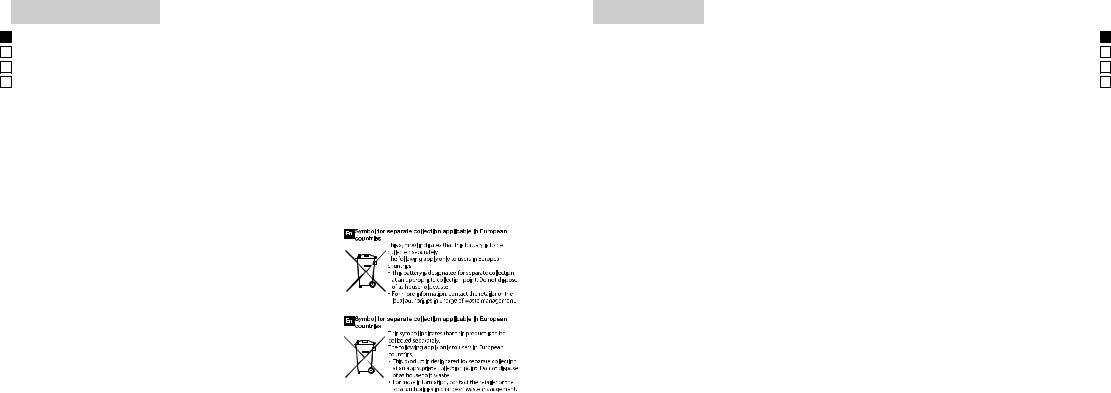
Es
Fr
Pt
Cautions before use
SAFETY PRECAUTIONS
 Cautions
Cautions
•Although the Nikon Laser
Rangefinder is waterproof, it is not designed for use underwater.
•Rain, water, sand and mud should be removed from the rangefinder body surface as soon as possible, using a soft, clean cloth.
•Do not leave the Nikon Laser
Rangefinder in a car on a hot or sunny day, or near heat-generating equipment. This may damage or negatively affect it.
•Do not leave the Nikon Laser
Rangefinder in direct sunlight.
Ultraviolet rays and excessive heat may negatively affect or even damage the unit.
•If the Nikon Laser Rangefinder is exposed to sudden changes in temperature, water condensation may occur on lens surfaces. Do not use the product until the condensation has evaporated.
CARE AND MAINTENANCE
Lenses
•When removing dust on the lens surface, use a soft oil-free brush.
•When removing stains or smudges like fingerprints from the lens surface, wipe the lenses very gently with a soft clean cotton cloth or quality oil-free lens tissue. Use a small quantity of pure alcohol (not denatured) to wipe stubborn smudges. Do not use velvet cloth or ordinary tissue, as it may scratch the lens surface. Once the cloth has been used for cleaning the body, it should not be used again for the lens surface.
Main body
•Clean the body surface with a soft, clean cloth after blowing away dust with a blower* lightly. Do not use benzene, thinner, or other cleaners containing organic solvents.
*A blower is rubber cleaning equipment that blows air from a nozzle.
Storage
•Water condensation or mold may occur on the lens surface because of high humidity. Therefore, store the Nikon Laser Rangefinder in a cool, dry place.
After use on a rainy day or at night, thoroughly dry it at room temperature, then store in a cool, dry place.
Key Features
• Linear distance measurement range: 10-550 meters/11-600 yards
• Distance measurement display step: 0.1 meter/yard
Easy-to-aim 6x optical observation system
Results are displayed on an internal LCD panel
Measured and displayed in Distant Target Priority
Waterproof design (NOT designed for underwater usage)
Invisible/Eyesafe EN/IEC Class 1M Laser
8-second results display
Compact, lightweight, ergonomic design
Automatic power shut-off (after approx. 8 sec. unattended)
Default to “Last Use” settings
Single or continuous measurement (up to approx. 8 seconds)
The Nikon Laser Rangefinder uses an invisible laser beam for measuring. It measures the time the laser beam takes to travel from the rangefinder
to the target and back. Laser reflectivity and measurement results may vary according to climatic and environmental conditions, as well as the color, surface finish, size, shape and other characteristics of the target.
The following conditions makes measuring easier:
•Night time use rather than bright daytime
•Cloudy weather rather than in direct sunlight
•Bright-colored targets
•Targets with highly reflective surfaces
•Targets with shiny exteriors
•Large-size targets
•Laser incident angle to the target is close to 90 degrees
Measurement may result in inaccuracy or failure in the following cases:
•Slender or small target
•Target has diffusing reflective surface
•Target does not reflect the laser beam to the rangefinder (glass, a mirror, etc.)
•Black target
•Target has varying depths
•In snow, rain or fog
•Target measured through glass
•Reflective surface measured from diagonal direction
•Moving target
•Obstacle moving in front of the target
•When targeting the surface of water
Es
Fr
Pt
|
|
|
|
|
8 |
9 |
|||
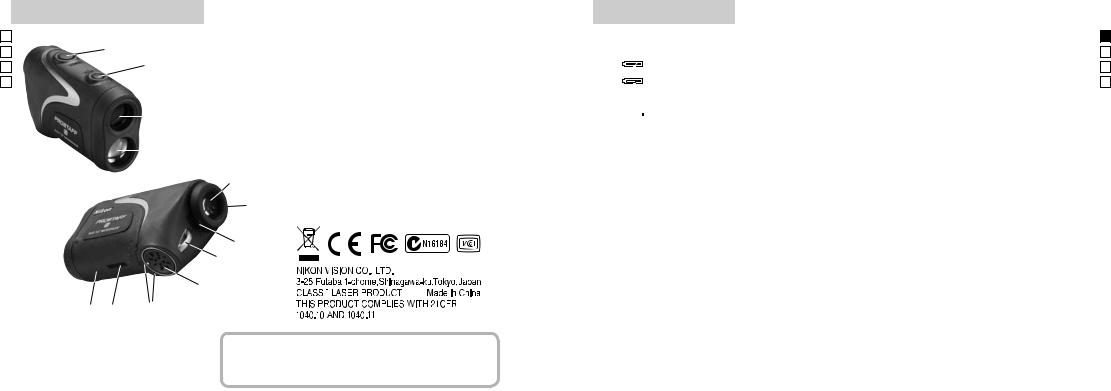
Nomenclature/Composition
|
4 |
|
|
|
|
|
|
1 Monocular objective lens/ |
Es |
|
|
|
|
|
|
||
|
|
|
|
|
|
|
Laser emission aperture |
|
Fr |
3 |
|
|
|
|
|||
|
|
|
|
|
|
|
2 Laser detector aperture |
|
Pt |
|
|
|
|
|
|
|
|
|
|
|
|
|
|
|
3 MODE button |
|
|
|
|
|
|
|
|
|
|
|
|
|
|
|
|
|
|
4 POWER button |
|
|
|
|
|
1 |
|
|
5 6x monocular eyepiece |
|
|
|
|
|
||||
|
|
|
|
|
|
|
|
6 Eyecup/diopteradjustment ring |
|
|
|
|
2 |
|
|
7 Diopter index |
|
|
|
|
|
|
8 Strap eyelet |
|||
|
|
|
|
|
|
|
|
|
|
|
|
|
|
|
5 |
|
9 Battery chamber cover |
|
|
|
|
|
|
|
!p Battery chamber cover“Open/Close”indication |
|
|
|
|
|
|
|
|
|
|
|
|
|
|
|
|
|
6 |
!q Product number label |
|
|
|
|
|
|
|
!w FDA information indication |
|
|
|
|
|
|
|
|
|
|
|
|
|
|
|
|
7 |
|
|
|
|
|
|
|
|
8 |
|
|
9
!w |
!q |
!p |
|
Composition
Body ................................... |
x1 |
Neckstrap ......................... |
x1 |
Soft case ........................... |
x1 |
Lithium battery (CR2) .. |
x1 |
Changing Battery
•Type of battery: 3V CR2 lithium battery
•Battery condition indicators
: Battery has enough power for use.
: Battery is getting low.
 flashing : Battery is low and battery should be replaced.
flashing : Battery is low and battery should be replaced.  disappears : Battery is exhausted and should be replaced.
disappears : Battery is exhausted and should be replaced.
*Flashing battery mark  on the LCD warns that the battery should be replaced.
on the LCD warns that the battery should be replaced.
1 Open the battery chamber cover
Using the ball of the thumb, etc. in the recessed part of the battery chamber cover, rotate the cover following the Open/Close arrow indicator. It may not open easily due to its rubber packing for water resistance.
2Replace the old battery with a new one
Insert a new battery with the [+] and [-] correctly positioned following the“Battery installation” indication seal in the battery chamber. [+] pole should be towards the inside of the chamber. If the battery is not inserted correctly, the Nikon Laser Rangefinder will not operate.
3Close the battery chamber cover
Align the Open/Close indicator with the white dot and insert the battery chamber cover. Using the ball of the thumb, etc., turn the cover following the arrow indicator. It may not close easily due to the rubber packing for water resistance, but continue to turn it all the way until it stops. Confirm that the cover is securely closed.
•Battery life
Continuous operation: Approx.13,000 times (at approx.20°C)
Target focusing, measurement, and automatic power-off are included in a single cycle. This figure may differ according to condition, temperature, and other factors such as target shape, color, etc.
*The Nikon Laser Rangefinder comes with a 3V CR2 lithium battery. However, due to natural electric discharge, the life of this battery will likely be shorter than that noted above.
*Replace the battery if the Nikon Laser Rangefinder is ever submerged in water or if water enters the battery chamber.
Es
Fr
Pt
10 |
11 |
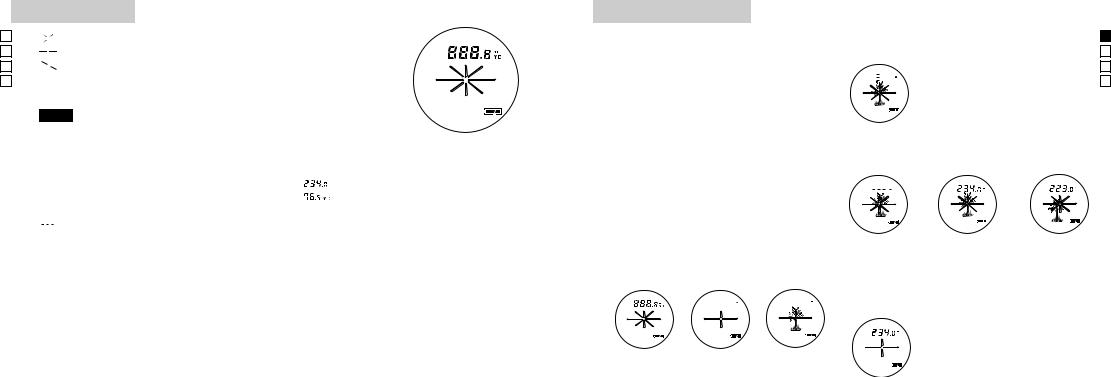
Internal display
|
1. |
- Target mark/Laser irradiation |
Es |
|
- Aim at the target. Position the target at the center of the reticle. |
Fr |
|
- Appears while the laser is being used for a measurement. (Remains |
Pt |
|
constant for a single measuremet, blinks during continuous |
|
|
measurement.) |
|
|
Warning: Do not look into the objective lenses when this mark is shown. |
2 




 : Distance/measurement status display.
: Distance/measurement status display.
Digitally indicates measured distance in meters/yards. Also indicates measuring status such as “Measurement in progress”, “Measurement unsuccessful” or “Unable
to measure.” |
|
|
|
<Examples of measurement results> |
|
|
|
(Distance) |
|
|
|
Display of results: ( 100m/yards) |
e.g. 234 meters = |
||
Display of results: ( 100m/yards) |
e.g. 76.5 yards = |
|
|
 - Now measuring
- Now measuring
- Failure to measure or unable to measure distance.
3.
 Display Units:
Display Units:
 Indicates distance being measured in meters.
Indicates distance being measured in meters.
 Indicates distance being measured in yards.
Indicates distance being measured in yards.
4. Indicates battery condition. (See "Changing Battery")
Indicates battery condition. (See "Changing Battery")
*Although the LCD is produced using the most advanced technology, it is impossible to eliminate dust completely. An LCD usually displays at the same magnification or lower, however, the LCD of this unit is highly magnified by the eyepiece lens. Because of this, when using this product, dust may appear as a defect. This will not, however, affect measurement accuracy.
Operational Summary
Caution — use of controls or adjustments or performance of procedures other than those specified herein may result in hazardous radiation exposure.
1.Install a battery in the battery chamber. (See "Changing Battery")
2.Diopter adjustment
Adjust diopter to obtain a clear image in the LCD. First, rotate the diopter adjustment ring counterclockwise until it comes to a complete stop.
Next, turn on the power to activate the LCD when you look through the Nikon Laser Rangefinder.
Rotate the diopter adjustment ring clockwise until the display comes into focus.
If the diopter is not adjusted to correspond to your eyesight, you may not be able to correctly aim at your subject.
3.Measuring
Before measuring, be sure to confirm unit setting.
1. Press the POWER |
2. Aim at the target. |
button for power-on. |
Immediately |
Stand-by. |
Target aiming. |
after power-on. |
|
|
(Initializing) |
|
|
3.Press POWER button once to start measurement.
Keeping the button depressed enables continous measurement up to approx. 8 seconds.
Measuring.
4. During measurement, the internal display shows “distance” and “fail to measure”indicator alternately. (Laser irradiation mark is blinking.)
Failure to measure or |
Displays the |
Displays the |
unable to measure |
measured figure. |
measured figure. |
distance. |
(Target 1) |
(Target 2) |
5.After measurement, the measured results are displayed for 8
seconds, then power turns off. If you press the POWER button during power-on (while the internal display is active), another measurement starts.
Es
Fr
Pt
12 |
13 |
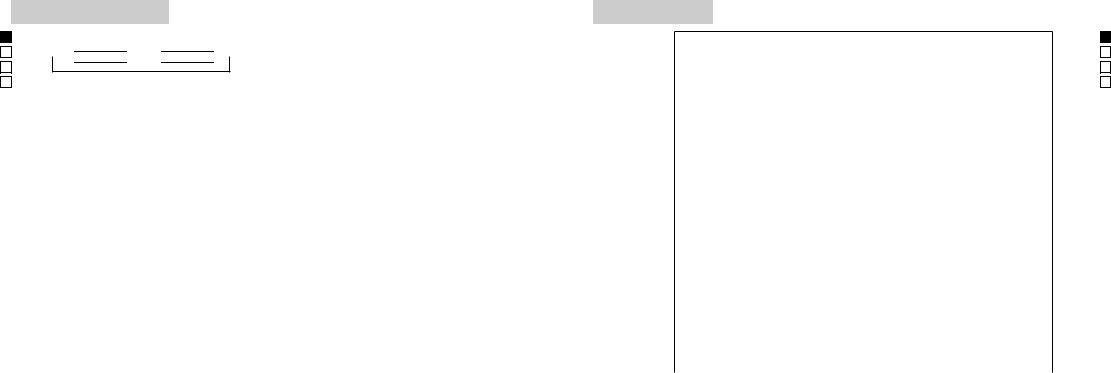
Es
Fr
Pt
Operational Summary
4. Selecting display unit (default setting is yards)

 Yard [
Yard [  ]
] 
 Meter [
Meter [  ]
] 
1. Confirm the internal LCD panel is on.
2. Press and hold the MODE button (2 seconds or longer).
3. After the display unit has changed, release the MODE button.
4. After the unit is set, results will be converted and displayed in the your selected measurement unit.
5. Distance display
The PROSTAFF 5 employs the Distant Target Priority System.
When obtaining different results from a single measuring operation, it will display the distance to the farthest target on the LCD panel.
e.g.)When measuring a tree standing in front of a house;
|
Tree |
Fence |
House |
|
|
|
|
Distance to Target |
115m |
123m |
128m |
|
|
|
|
"128m" (distance to the house) will be displayed.
This is useful for hunting in heavily wooded areas.
6.Low battery indication
Flashing  indicates that the battery power is low and the battery should be replaced. (See
indicates that the battery power is low and the battery should be replaced. (See
"Changing Battery")
7.Backlight
Use the backlight to see the LCD panel in dark conditions.
By pressing the MODE button briefly (less than 2 seconds) while the power is on, the backlight can be turned ON and OFF. The backlight can also be turned off by turning the laser rangefinder’s power off. In this case, the backlight will be off when the
Laser rangefinder’s power is turned on again.
Specifications
Measurement system
Measurement range |
Distance: 10-550 meters/11-600 yards |
|
Distance display (increment) |
0.1 meter/yard |
|
Target system |
Distant Target Priority System |
|
Measuring system |
Single/Continuous mode |
|
Optical system |
|
|
Type |
Roof-prism monocular |
|
Magnification (x) |
6 |
|
Effective diameter of objective lens |
ø21 |
|
(mm) |
||
|
||
Angular field of view (real) (˚) |
7.5 |
|
Eye relief (mm) |
18.3 |
|
Exit pupil (mm) |
ø3.5 |
|
Diopter adjustment |
±4m-1 |
|
Others |
|
|
Operating temperature (˚C) |
-10 — +50 |
|
Power source |
CR2 lithium battery x 1 (DC 3V) |
|
Dimensions (L x H xW) (mm) |
111 x 40 x 70 |
|
Weight (g) |
Approx. 165 (without battery) |
|
|
Body:Waterproof (maximum depth of 1 meter for up |
|
Structure |
to 10 minutes)* |
|
|
(Battery chamber:Water resistant**) |
|
Safety |
Class 1M Laser Product (EN/IEC60825-1:2007) |
|
Class I Laser Product (FDA/21 CFR Part 1040.10:1985) |
||
|
||
EMC |
FCC Part15 SubPartB class B, EU:EMC directive, AS/ |
|
NZS, VCCI classB |
||
|
||
Environment |
RoHS,WEEE |
Es
Fr
Pt
14 |
15 |

Es
Fr
Pt
Specifications
Laser
Class |
EN/IEC Class 1M |
Wavelength (nm) |
905 |
Pulse duration (ns) |
12 |
Output (W) |
15 |
Beam divergence (˚) |
Vertical: 23, Horizontal: 10 |
Operating humidity |
80%RH (without dew condensation) |
*Waterproof models
The Nikon Laser Rangefinder is waterproof, and will suffer no damage to the optical system if submerged or dropped in watertoamaximum depthof1 meter for upto10 minutes.
The Nikon Laser Rangefinder offers the following advantages:
•Can beusedin conditions ofhigh humidity, dust andrain withoutriskof damage.
•Nitrogen-filleddesignmakes it resistant to condensation andmold.
Observe the following when using the Nikon Laser Rangefinder.
•The unit should not beoperatednor heldin running water.
•If any moistureis found on movable parts ofthe NikonLaser Rangefinder,stopusing it and wipeit off.
Tokeep your Nikon LaserRangefinderin excellent condition, NikonVision recommendsregularservicingbyan authorized dealer.
**The battery chamberis waterresistant,notwaterproof.Water mayenterthedevice iftheNikonLaser Rangefinder is submerged in water. If water enters the battery chamber, wipe out any moisture and allow time for the chamber to dry.
Others
This device complies with Part 15 of the FCC Rules. Operation is subject to the following two conditions: |
|
Es |
|
(1)This device may not cause harmful interference, and |
Fr |
(2)This device must accept any interference received, including interference that may cause undesired operation. |
Pt |
|
|
This equipment has been tested and found to comply with the limits for a Class B digital device, pursuant to Part |
|
15 of the FCC Rules and to EU EMC directive.These limits are designed to provide reasonable protection against |
|
harmful interference in a residential installation. This equipment generates, uses and can radiate radio frequency |
|
energy and, if not installed and used in accordance with the instructions, may cause harmful interference to radio |
|
communications. However, there is no guarantee that interference will not occur in a particular installation. If this |
|
equipment does cause harmful interference to radio or television reception, which can be determined by turning |
|
the equipment off and on, the user is encouraged to try to correct the interference by one or more of the following |
|
measures: |
|
• Reorient or relocate the receiving antenna. |
|
• Increase the separation between the equipment and receiver. |
|
• Consult the dealer or an experienced radio/TV technician for help. |
|
This Class B digital apparatus meets all requirements of the Canadian Interference-Causing Equipment Regulations. |
|
This Nikon Laser Rangefinder is a basic rangefinder. Its results cannot be used as official evidence. |
|
16 |
17 |

Es
Fr
Pt
Troubleshooting/Repair
If your Nikon Laser Rangefinder should require repair, please contact your local dealer for details regarding where to send it. Before doing so, you are advised to consult the Troubleshooting Table below.
Symptom |
Check Points |
|
|
|
|
Unit does not turn on — LCD fails to |
• Depress POWER button. |
|
• Check battery insertion |
||
illuminate |
||
• Replace the battery if necessary. |
||
|
||
|
• Be sure that nothing, such as your hand or finger, is blocking the laser |
|
|
emission aperture and laser detector. |
|
|
• Be sure that the laser emission aperture and laser detector are clean. |
|
Target range cannot be obtained |
Clean them if necessary. |
|
|
• Be sure that the target shape and condition are appropriate to reflect the |
|
|
laser beam. |
|
|
• Replace battery. |
|
[- - -] (“Cannot measure”) appears |
• Be sure to hold the unit steady while measuring. |
|
|
• Be sure the target is within measuring range (10-550m/11-600 yards) |
|
Closer target cannot be measured |
• Be sure that nothing, such as leaves or grass, is between the Nikon Laser |
|
|
Rangefinder and the target. |
|
Target beyond a certain distance |
• Be sure that nothing, such as leaves or grass, is between the Nikon Laser |
|
cannot be measured |
Rangefinder and the target. |
|
|
|
Symptom |
Check Points |
|
|
|
|
|
• Replace the battery. |
|
|
• Be sure that the target shape and condition are appropriate to reflect the |
|
Measurement result is unstable |
laser beam. |
|
• Be sure to hold the unit steady while measuring. |
||
|
||
|
• Be sure that nothing, such as leaves or grass, is between the Nikon Laser |
|
|
Rangefinder and the target. |
|
|
|
|
|
• Replace battery. |
|
|
• Be sure that the target shape and condition are appropriate to reflect the |
|
Incorrect result is displayed |
laser beam. |
|
|
• Be sure that nothing, such as leaves or grass, is between the Nikon Laser |
|
|
Rangefinder and the target. |
|
|
|
If problems persist after consulting theTroubleshootingTable, please contact your local dealer to check/repair the Nikon Laser Rangefinder. Never let anyone other than the official representative of the product manufacturer check or repair the Nikon Laser Rangefinder. Failure to follow this instruction could result in injury, or damage to the product.
Es
Fr
Pt
18 |
19 |

En
Fr
Pt
Español |
|
CONTENIDO |
|
Precauciones antes del uso ................................ |
21-24 |
Características clave ..................................................... |
25 |
Nomenclatura/Componentes .................................. |
26 |
Cambio de la batería .................................................... |
27 |
Pantalla interna .............................................................. |
28 |
Resumen operativo ............................................... |
29-30 |
Especificaciones ..................................................... |
31-32 |
Otros .................................................................................. |
33 |
Solución de problemas/Reparación ................ |
34-35 |
Precauciones antes del uso
Gracias por adquirir el telémetro láser PROSTAFF 5 de Nikon.
El PROSTAFF 5 es un telémetro láser de gama alta especializado en la medición de distancias reales y destinado a aplicaciones de ocio, deportes y otras situaciones en exteriores.
Respete estrictamente las orientaciones siguientes para utilizar correctamente el equipo y evitar accidentes que podrían ser peligrosos.
La utilización de controles, ajustes o parámetros de procedimiento distintos de los aquí indicados puede provocar una exposición a radiaciones peligrosas.
qAntes de utilizar el producto lea atentamente las "Precauciones antes del uso" y las instrucciones de uso correcto que acompañan al producto.
qTenga a mano este manual para consultarlo cuando lo precise.
qNo desmonte ni repare este producto usted mismo, puede provocar algún problema grave. Un producto que haya sido desmontado o reparado pierde la garantía del fabricante.
•Las especificaciones y el diseño pueden cambiar sin aviso previo.
•Se prohíbe la reproducción de este manual en cualquier forma, ya sea en su totalidad o en parte (excepto citas breves en artículos críticos o revisiones), sin la autorización escrita de NIKON VISION
CO., LTD.
En
Fr
Pt
20 |
21 |
